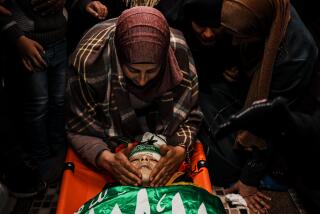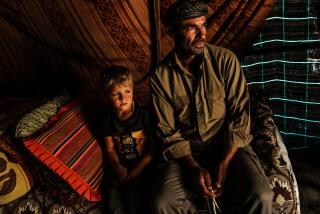Pact Brings No Peace to Kosovo Villagers
- Share via
KRAJKOVA, Yugoslavia — The boy’s body had been in the ground a few minutes when four rifle shots rang out and villagers mourning a child’s death had to duck bullets whistling over their heads.
The crack of gunfire came from a nearby hill, from the same direction as the bullet that pierced 10-year-old Shemsi Elshani’s left shoulder a day earlier and then blew a large hole out his back.
Shemsi was cutting firewood at the edge of a forest overlooking this village when he was killed shortly after noon Saturday. His father blames Serbian police posted about half a mile away, easy range for a good sniper.
“We were there two hours, cutting trees and carrying the logs,” Rashit Elshani, 37, said Sunday before he buried Shemsi on a hilltop straight across from the police post.
“We saw them without binoculars. And they had binoculars, so they could see us.”
Elshani, a history teacher in the village school, squeezed the tiny hand of his younger son, Dardan, as he spoke. The 7-year-old boy, whose bright blue eyes stared up from under a corduroy cap, is the only child Elshani has left.
It is impossible to know for sure whether Shemsi was murdered or was the victim of a stray bullet in a dark stretch of Kosovo where bursts of gunfire rattle off day and night.
But Serbian paramilitary police, who destroyed much of the province in eight months of full-scale war against separatist guerrillas, still maintain a heavily armed post in the nearby village of Poklek, residents of Krajkova said.
That leaves this region, like Kosovo itself, in the nether world between war and peace, its people caught in what military strategists call a low-intensity conflict--plain war to Shemsi’s family.
Few Ethnic Albanians Believe NATO Threat
Under an Oct. 12 agreement brokered by U.S. envoy Richard Holbrooke, Yugoslav President Slobodan Milosevic is supposed to be withdrawing most of his security forces from the Serbian province. Serbia is the larger of the two republics that remain part of Yugoslavia.
In turn, NATO has given Milosevic until Tuesday to show he is keeping that promise or face escalating airstrikes, but few in Kosovo’s ethnic Albanian majority believe that threat anymore.
U.S. Gen. Wesley Clark, the North Atlantic Treaty Organization’s supreme commander, brought German Gen. Klaus Naumann, a top NATO official, to the Yugoslav and Serbian capital, Belgrade, over the weekend to try to keep the pressure on Milosevic.
They met with the Yugoslav president and his army chief of staff, Gen. Momcilo Perisic, through the night Saturday for about 12 hours.
The talks continued until about 5 a.m. Sunday and then resumed for a few hours later in the day. But by afternoon, police and army units were still dug in throughout Kosovo.
Ambassadors to the 16-nation NATO alliance are due to meet Tuesday to decide whether to go ahead with airstrikes, give Milosevic another extension or leave the threat open-ended.
The last option is considered NATO’s most likely choice because diplomatic observers say that Milosevic is making progress and that an informal cease-fire is holding despite constant skirmishes.
Also, an estimated 10,000 refugees driven from their homes in Kosovo are still living in tents of plastic tarp, and relief workers have warned that NATO attacks could make it impossible to keep their lifeline to the refugees open.
As villagers waited Sunday to bury Shemsi Elshani, a small group of European and American diplomatic observers came to look at the boy’s body and the place where he died to see what evidence they could gather.
The bursts of gunfire were especially heavy just before the funeral was supposed to start, and the men digging Shemsi’s grave with a pickax and shovel sprawled in the dirt for cover.
By then, however, the European observers had already left, so frightened villagers asked the American diplomats if they could drive their armored truck, with a large American flag on the side, up the hill to the grave site.
American diplomat Norman Olsen agreed to make a phone call, apparently to check for permission to go to the funeral. He returned to tell the villagers that he couldn’t accompany them to Shemsi’s burial.
“I want to be honest and say that, without prior work, our presence at the grave site will not protect anyone,” Olsen said. “And if any other diplomat says they can protect them, then they don’t know what they are saying.”
Children Have Learned to Be Brave Under Fire
In the farmhouse behind Olsen, Shemsi’s body lay on the floor, covered by two thin blankets and still dressed in the clothes he was wearing while chopping wood to keep his family’s house warm.
About 20 women, their heads covered in white scarves, sat on cushions against one wall and wailed over the young corpse. Shemsi’s mother, Hasime, 37, sat beside him and wept as a man lifted the blankets to display the body.
Bits of sawdust and dirt from where he fell still clung to the boy’s sandy brown hair. A crust of dried blood circled a small bullet hole the size of a dime in the left shoulder of the sweatshirt he wore over a turtleneck.
Elshani was about 200 yards away from his son when the boy was fatally shot and a cousin chopping wood nearby was wounded. The cousin’s 16-year-old sister crawled through the bush to reach Shemsi and carry his body out.
“We tried to stop her, but she was determined to go,” Elshani said.
Kosovo’s children have learned to be brave under fire.
“When this agreement was signed between Holbrooke and Milosevic, 24 new armored vehicles arrived near here,” cousin Maliq Elshani, 46, said through an interpreter. “From the position where they shot Saturday, there were four armored vehicles.”
The Holbrooke agreement “is only words,” added Maliq, who was outside the day Shemsi was shot and heard the gunfire.
There were at least three shots, he said. The exit wound in Shemsi’s body was so big that he wonders whether the boy was hit by a high-caliber bullet from a machine gun or an expanding dum-dum round from a sniper’s rifle.
Shemsi’s family abandoned their home during a Serbian offensive in the summer but came back a month ago to the two-story house with a red tile roof that stands on the village’s exposed edge.
Each night, the temperature drops close to freezing, and with winter only a few weeks away, the family had to start stockpiling firewood. Saturday was the first day that they felt safe enough to go out and get some.
Gunshots Scatter Mourners at Funeral
On Sunday, the pallbearers carried Shemsi’s body, shrouded in blankets and laid out on a rough-hewn wooden frame with a bouquet of flowers at his feet, to the hilltop graveyard where six bodies already lay. The dead buried there were all either neighbors or relatives of Shemsi, and they were all killed on the same day, Sept. 25, during a Serbian offensive.
The villagers gently lowered Shemsi’s body into the ground next to theirs, without a coffin, and placed four planks over his corpse.
The gravediggers hurried to bury him. They had been under fire all morning and were certain that the shots were coming from the police post.
Shemsi’s mother placed a white rose on his grave as a man knelt on the ground nearby to write in small letters, in black ballpoint, on a wooden grave marker: “Shemsi R. Elshani 04.12.1987 -- 24.10.1998.”
After a brief reading honoring the dead as martyrs, the mourners turned to hurry back to the village. And then the shots rang out. As people scattered and ducked, Shemsi’s mother collapsed, in grief, on the hillside.
More to Read
Sign up for Essential California
The most important California stories and recommendations in your inbox every morning.
You may occasionally receive promotional content from the Los Angeles Times.












